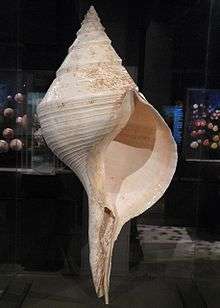Sea snail
.jpg)
Sea snail is a common name for snails that normally live in saltwater, in other words marine gastropods. The taxonomic class Gastropoda also includes snails that live in other habitats, such as land snails and freshwater snails. Many species of sea snails are edible and exploited as food sources by humans.
Sea snails are marine gastropods with shells. Those marine gastropods with no shells, or only internal shells, are variously known by other common names, including sea slug, sea hare, nudibranch, etc. The diversity within sea snails is enormous. Many very different clades of gastropods are either dominated by, or consist exclusively of, sea snails. Because of this great variability, generalization about the feeding, reproduction, habitat, or other traits of sea snails is not possible. Instead, individual clades, families, genera, or species must be assessed.
Shells

The shells of most species of sea snails are spirally coiled. Some, though, have conical shells, and these are often referred to by the common name of limpets. In one unusual family (Juliidae), the shell of the snail has become two hinged plates closely resembling those of a bivalve; this family is sometimes called the "bivalved gastropods".
Their shells are found in a variety of shapes and sizes, but are normally very small. Those of living species of sea snails range in size from Syrinx aruanus, the largest living shelled gastropod species at 91 cm, to minute species whose shells are less than 1 mm at adult size. Because the shells of sea snails are strong and durable in many cases, as a group they are well represented in the fossil record.
Anatomy
Sea snails are a very large group of animals and a very diverse one. Most snails that live in saltwater respire using a gill or gills, a few species, though, have a lung, are intertidal, and are active only at low tide when they can move around in the air. These air-breathing species include false limpets in the family Siphonariidae and another group of false limpets in the family Trimusculidae.
Many, but not all sea snails have an operculum.
Human uses
A number of species of sea snails are used by humans for food, including abalone, conch, limpets, whelks (such as the North American Busycon species and the North Atlantic Buccinum undatum) and periwinkles including Littorina littorea.
The shells of sea snails are often found by humans as seashells commonly wash up on beaches. Because the shells of many sea snails are attractive and durable, they have been used by humans to make necklaces and other jewelry from prehistoric times to the current day.
The shells of a few species of large sea snails within the Vetigastropoda have a thick layer of nacre and have been used as a source of mother of pearl. Historically, the button industry relied on these species for a number of years.
Use by other animals
The shells of sea snails are used for protection by many kinds of hermit crabs. A hermit crab carries the shell by grasping the central columella of the shell using claspers on the tip of its abdomen.
Definition
Determining whether some gastropods should be called sea snails is not always easy. Some species that live in brackish water (such as certain neritids) can be listed as either freshwater snails or marine snails, and some species that live at or just above the high tide level (for example species in the genus Truncatella) are sometimes considered to be sea snails and sometimes listed as land snails.
Taxonomy
2005 taxonomy
The following cladogram is an overview of the main clades of living gastropods based on the taxonomy of Bouchet & Rocroi (2005),[1] with taxa that contain saltwater or brackish water species marked in boldface (some of the highlighted taxa consist entirely of marine species, but some of them also contain freshwater or land species.)


- Clade Patellogastropoda
- Clade Vetigastropoda
- Clade Cocculiniformia
- Clade Neritimorpha
- Clade Cycloneritimorpha
- Clade Caenogastropoda
- Informal group Architaenioglossa
- Clade Sorbeoconcha
- Clade Hypsogastropoda
- Clade Littorinimorpha
- Informal group Ptenoglossa
- Clade Neogastropoda
- Clade Heterobranchia
- Informal group Lower Heterobranchia
- Informal group Opisthobranchia
- Clade Cephalaspidea
- Clade Thecosomata
- Clade Gymnosomata
- Clade Aplysiomorpha
- Group Acochlidiacea
- Clade Sacoglossa
- Group Cylindrobullida
- Clade Umbraculida
- Clade Nudipleura
- Clade Pleurobranchomorpha
- Clade Nudibranchia
- Clade Euctenidiacea
- Clade Dexiarchia
- Clade Pseudoeuctenidiacea
- Clade Cladobranchia
- Clade Euarminida
- Clade Dendronotida
- Clade Aeolidida
- Informal group Pulmonata
- Informal group Basommatophora
- Clade Eupulmonata
- Clade Systellommatophora
- Clade Stylommatophora
- Clade Elasmognatha
- Clade Orthurethra
- Informal group Sigmurethra
See also
References
- ↑ Bouchet P.; Rocroi J.-P.; Frýda J.; Hausdorf B.; Ponder W.; Valdés Á. & Warén A. (2005). "Classification and nomenclator of gastropod families". Malacologia: International Journal of Malacology. Hackenheim, Germany: ConchBooks. 47 (1-2): 1–397. ISBN 3-925919-72-4. ISSN 0076-2997.